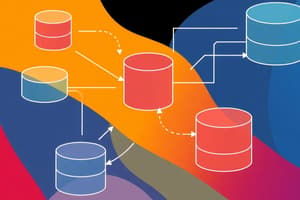Podcast
Questions and Answers
What is the primary purpose of data modeling?
What is the primary purpose of data modeling?
- To identify entities and their relationships (correct)
- To design a database table
- To implement a database using SQL
- To create a logical data model
What are the three components of a data model?
What are the three components of a data model?
- Entities, attributes, and relationships (correct)
- Database, SQL, and schema
- Tables, rows, and columns
- Data, information, and knowledge
What is an example of a qualitative attribute?
What is an example of a qualitative attribute?
- Genre (correct)
- Number of pages
- Price
- Author
What is the first step in creating a data model?
What is the first step in creating a data model?
What is an entity in the context of data modeling?
What is an entity in the context of data modeling?
What is the purpose of the exercise in identifying attributes for different entities?
What is the purpose of the exercise in identifying attributes for different entities?
What is a characteristic of a well-designed data model?
What is a characteristic of a well-designed data model?
What is the final step in creating a data model?
What is the final step in creating a data model?
What is the primary function of a Database Management System (DBMS)?
What is the primary function of a Database Management System (DBMS)?
What is the relationship between a table and an entity in a relational database?
What is the relationship between a table and an entity in a relational database?
What is the purpose of the SQL language in a relational database?
What is the purpose of the SQL language in a relational database?
What is the function of the CREATE TABLE command in SQL?
What is the function of the CREATE TABLE command in SQL?
What type of database management system is MySQL?
What type of database management system is MySQL?
What is the correct syntax to create a new database in MySQL?
What is the correct syntax to create a new database in MySQL?
What is the purpose of the USE command in MySQL?
What is the purpose of the USE command in MySQL?
What is the correct syntax to insert data into a table in MySQL?
What is the correct syntax to insert data into a table in MySQL?
What is the correct syntax to retrieve data from a table in MySQL?
What is the correct syntax to retrieve data from a table in MySQL?
What is the correct syntax to update data in a table in MySQL?
What is the correct syntax to update data in a table in MySQL?
Flashcards are hidden until you start studying
Study Notes
Data Modeling Concepts
- Data modeling is similar to building design or engineering drawings in the real world
- A data model contains:
- Entities (things of interest that we want to store data about)
- Attributes (information about the entities)
- Relationships (how the entities relate to each other)
Entities
- An entity is something of interest that we want to store data about
- Entities can be physical real-world objects or conceptual things
- Examples of entities:
- Book
- Author
- Story
- News article
- Customer
- Address
Attributes
- An attribute is a specific characteristic or data point about an entity
- Attributes can be:
- Qualitative (non-numeric)
- Quantitative (numeric)
- Examples of attributes for a book entity:
- Title
- Number of pages
- Author
- Genre
Process of Creating a Data Model
- Step 1: Identify significant entities about which we want to store data
- Step 2: Create a logical data model to explain the relationships between entities
- Step 3: Determine the attributes for each entity
- Step 4: Design the database tables
- Step 5: Implement the design using Structured Query Language (SQL)
Exercise
- Identify at least 10 attributes for each of the following entities:
- Person
- Car
- Country
- Smartphone
- Bank account
- Class
- Pet
- Apartment
- Create a table with columns for:
- Attribute
- Data type
- Description
- Is it required or not?
Data Modeling Concepts
- Data modeling is a process of creating a conceptual representation of data structures and relationships.
- A data model consists of three key components: entities, attributes, and relationships.
Entities
- Entities are objects or concepts of interest that we want to store data about.
- Examples of entities include physical objects, people, and conceptual things.
- Entities can be classified into two categories: physical real-world objects and conceptual things.
Attributes
- Attributes are specific characteristics or data points about an entity.
- Attributes can be qualitative (non-numeric) or quantitative (numeric).
- Examples of attributes for a book entity include title, number of pages, author, and genre.
Process of Creating a Data Model
- The process of creating a data model involves five steps:
Step 1: Identify Entities
- Identify significant entities about which we want to store data.
Step 2: Create Logical Data Model
- Create a logical data model to explain the relationships between entities.
Step 3: Determine Attributes
- Determine the attributes for each entity.
Step 4: Design Database Tables
- Design the database tables based on the logical data model and attributes.
Step 5: Implement the Design
- Implement the design using Structured Query Language (SQL).
Database Management Systems (DBMS)
- A DBMS is a computer system that stores, organizes, manages, and processes data.
- It enables users to define, record, query, update, and manage data.
- DBMS provides functionality to create, host, and manage databases.
Relational Databases
- Relational databases store data in tables with relationships between them.
- This course focuses on relational databases, specifically MySQL.
Entities and Attributes
- Entities are real-life things about which we want to store data.
- Examples of entities include a person, a book, a car, or a building.
- Attributes are the data itself, which can be physical characteristics (e.g., weight, height, color) or other types of information.
Data Models
- A data model is a larger design that includes multiple entities and their attributes.
- It is a conceptual design that helps us organize and structure data.
- Data models are similar to building designs or plans.
Databases and Tables
- A database is a collection of entities, which are stored in tables.
- A table is a physical representation of an entity, with each attribute becoming a field within the table.
- A database can contain multiple tables, and each table can have multiple fields.
MySQL
- MySQL is a specific relational database management system (RDBMS) used for this course.
- It is a software that runs as a server, and can be accessed using a client application like MySQL Workbench.
- MySQL uses a language called SQL (Structured Query Language) to interact with the database.
SQL Basics
- SQL is a language used to interact with relational databases.
- There are six basic constructs in SQL:
- CREATE TABLE: creates a new table.
- ALTER TABLE: modifies an existing table.
- DROP TABLE: deletes a table.
- INSERT: adds new records to a table.
- UPDATE: modifies existing records in a table.
- DELETE: deletes records from a table.
Exercise
- Create a table about an entity called "person" with three fields: first name, last name, and gender.
- Use the CREATE TABLE command to define the table.
- Use the INSERT statement to add three records to the table.
- Use the SELECT statement to list the records.
- Use the UPDATE statement to modify the records.
- Use the DELETE statement to delete the records from the table.
Connecting to MySQL Server
- Use the username as your last name and student ID as the password.
- In the port session, leave the port number as 3306.
Configuring MySQL Workbench
- The main window is where you will type SQL commands and send them to the server.
- The left-hand side window displays databases, which can be expanded to show tables, views, stored procedures, and functions.
Creating a New Database
- To create a new database, use the SQL command
CREATE DATABASE. - The command should end with a semicolon (
;).
Creating a New Table
- To create a new table, use the SQL command
CREATE TABLE. - Define the fields (attributes) of the table, including data types and lengths.
Using the Database
- To use the newly created database, use the SQL command
USE. - Once inside the database, you can create tables, insert data, and perform other operations.
Inserting Data into a Table
- To insert data into a table, use the SQL command
INSERT INTO. - Specify the columns and values to be inserted.
Retrieving Data from a Table
- To retrieve data from a table, use the SQL command
SELECT. - Example:
SELECT first_name, last_name, gender FROM person;
Updating Data in a Table
- To update data in a table, use the SQL command
UPDATE. - Example:
UPDATE person SET last_name = 'Do' WHERE first_name = 'Jane';
Exercise Summary
- Create a database table called "person" with three columns: first_name, last_name, and gender.
- Insert three records into the table using the INSERT command.
- Retrieve the data from the table using the SELECT command.
- Update one of the records using the UPDATE command.
Studying That Suits You
Use AI to generate personalized quizzes and flashcards to suit your learning preferences.





